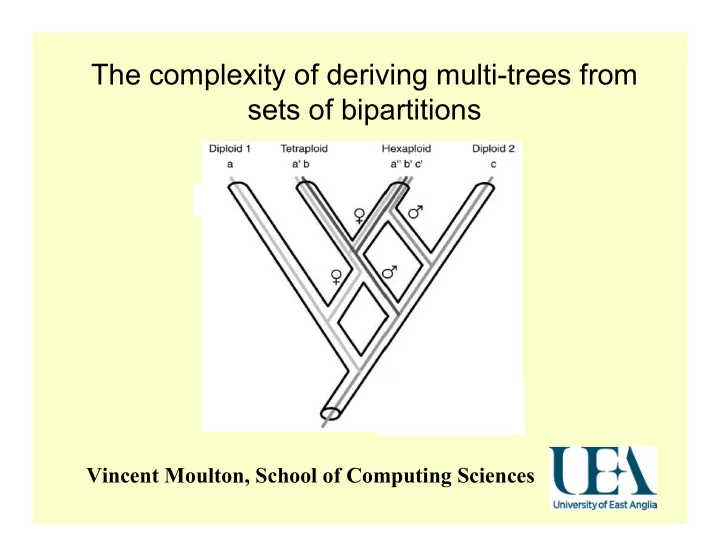

The complexity of deriving multi-trees from sets of bipartitions Vincent Moulton, School of Computing Sciences
Joint work with • Dr. Katharina Huber, Martin Lott, Dr. Andreas Spillner School of Computing Sciences,University of East Anglia • Prof. Bengt Oxelman, Anna Petri Department of Plant and Environmental Sciences, University of Gothenburg
Modelling polyploidy (multi-trees from networks) A B B C A B C
Networks from multi-trees? Smedmark et al., Systematic Biology, 2003
Multiple possibilties c b a b c c d b a b a c d b c d
Aim Given a multi-labeled tree T …. A B B C B C D A B C D …. construct a “most parsimonious” reticulate network displaying T
Merging leaves a b b c b b c c d a b b b b c d a b c d
Inextendible subtrees maximal inextendible inextendible b c a c b a b c
Construction T a a b b c b b c c d b b b c c d a a b c c d b c d D(T) Theorem [Huber,Moulton, 2006] D(T) is “minimal” network displaying T .
Question: How do we get the multi-tree?
Consensus trees C B D A D A A D C E C E E B B AB | CDE , ABC | DE AC |BDE, ABC | DE AB|DCE, ABD | CE C A D E B
Problem! Theorem Given a set S of splits of a multi-set M, it is NP-hard to decide if S can be displayed by a multi-tree (even if the multiplicity of all elements in M is bounded by 3). x x x x Idea for why this is the case: x M = {n x} “ x -tree” x x S = { n 1 x | (n-n 1 )x , … , n m x | (n-n m ) x} Deciding if we can display this set by a multi-tree is essentially equivalent to deciding if there is a subset of {n 1 ,.., n m } that adds up to n/2 .
Useful result and conjecture Given multiset M = {m(x) x} x in X , let Δ ( M ) = Σ x in X ( m(x) - 1). Theorem [Lott, Huber, Moulton, Spillner, in press] If every submultiset of size at most m := max {2 Δ , Δ +2} of a multiset of splits of M can be displayed by a multi-tree, then so can the whole collection. Conjecture m = Δ +2
Work in progress…
PADRE Martin Lott http://www.cmp.uea.ac.uk/~vlm/padre/
Recommend
More recommend